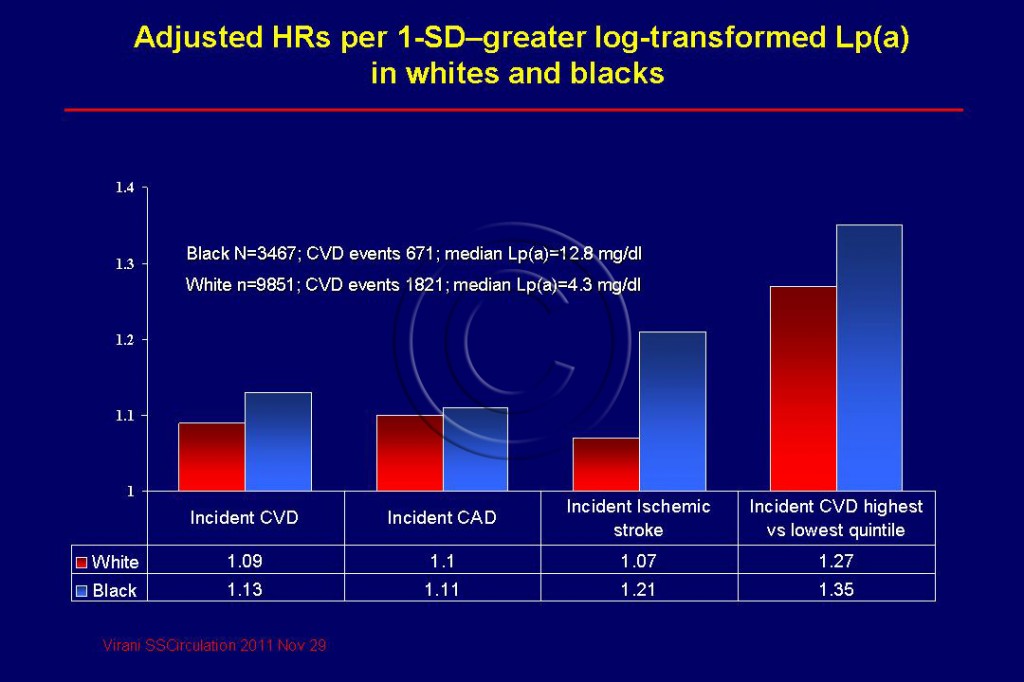Ethnicity
- Circulating lipoprotein(a) (Lp(a)) levels vary more than 7-fold among populations and generally parallel the rates of heart disease, with a few exceptions.1 Eskimos, Native Americans, Hispanics, Chinese, and French populations have low rates of heart disease, that is accompanied by low levels of Lp(a).1
- Blood levels of Lp(a)are similar in men and women and are skewed in the population with a tail toward the highest levels. Therefore median levels are more accurate than mean levels. 1
- Median levels are lowest in American Indians (3 mg/dl) followed by whites (12 mg/dL) and highest in blacks (39 mg/dl).2 The levels are intermediate among Chinese (11 mg/dl) and Japanese (13 mg/dl) Hispanics (19 mg/dl).3 Elevated Lp(a) levels (>25 to 30 mg/dl) are present in up to 30% of whites and 70% of blacks.4
- Blacks have the highest Lp(a) levels (2-3 fold higher than whites) and the distribution is less skewed than in whites. Nonetheless, Lp(a) confers less risk in blacks than in whites (Figure 039). This is primarily due to favorable distribution of Lp(a) isoforms with a low prevalence of the highly atherogenic small isoforms and high prevalence of relatively benign large Lp(a) isoforms.5-9 Besides blacks have an antiatherogenic lipid profile (lower LDL-C and triglyceride levels and higher HDL-C levels) which may counterbalance the atherogenic potential of Lp(a).8, 9
- Hispanics have higher Lp(a) levels than American Indians, but lower levels than whites. Besides, Hispanics with the highest percentage of American Indian heritage have even lower Lp(a) levels.10 These data underscore the importance of ethnicity and genetics in determining Lp(a) levels.1
- Japanese have Lp(a) levels similar to whites, although Chinese have lower levels than whites.11, 12 Lp(a) levels are more closely related to stroke among Chinese and Japanese ─ the predominant form of CVD in these populations.13-15
- The Asian Indians have the second highest level of Lp(a) and the levels are 3 times higher than the Chinese ─ a difference that is evident even in cord blood and parallel the wide difference in CAD rates between these 2 populations.1 High levels of Lp(a) are highly prevalent and highly correlated with malignant heart disease in young Indians.16 (see Lipoprotein(a) in Asian Indians)
- Unlike Asian Indians, blacks are somewhat protected against the dangers of Lp(a) by having a less dangerous form of it and by their high levels of HDL, which Indians typically lack.1
- However the 20 year follow up of ARIC study (266,360 person years of follow up and 2497 CVD events) has reported the CAD risk in African-Americans from elevated Lp(a) to be as strong as in whites. Strikingly Lp(a) conferred a greater risk of stroke in African-Americans than in whites.17 See Figure 111
Sources
1. Enas EA, Chacko V, Senthilkumar A, Puthumana N, Mohan V. Elevated lipoprotein(a)–a genetic risk factor for premature vascular disease in people with and without standard risk factors: a review. Dis Mon. Jan 2006;52(1):5-50.
2. Wang W, Hu D, Lee ET, et al. Lipoprotein(a) in American Indians is Low and Not Independently Associated with Cardiovascular Disease. The Strong Heart Study. Ann Epidemiol. 2002;12(2):107-114.
3. Matthews K. A, Sowers MF, Derby CA, et al. Ethnic differences in cardiovascular risk factor burden among middle-aged women: Study of Women’s Health Across the Nation (SWAN). Am Heart J. Jun 2005;149(6):1066-1073.
4.Guerra R, Yu Z, Marcovina S, Peshock R, Cohen JC, Hobbs HH. Lipoprotein(a) and apolipoprotein(a) isoforms: no association with coronary artery calcification in the Dallas Heart Study. Circulation. Mar 29 2005;111(12):1471-1479.
5. Paultre F, Pearson TA, Weil HF, et al. High levels of Lp(a) with a small apo(a) isoform are associated with coronary artery disease in African American and white men. Arterioscler Thromb Vasc Biol. 2000;20(12):2619-2624.
6. Marcovina SM, Albers JJ, Wijsman E, Zhang Z, Chapman NH, Kennedy H. Differences in Lp[a] concentrations and apo[a] polymorphs between black and white Americans. J Lipid Res. 1996;37(12):2569-2585.
7. Paultre F, Tuck CH, Boden-Albala B, et al. Relation of Apo(a) Size to Carotid Atherosclerosis in an Elderly Multiethnic Population. Arterioscler Thromb Vasc Biol. 2002;22(1):141-146.
8. Brown SA, Hutchinson R, Morrisett J, et al. Plasma lipid, lipoprotein cholesterol, and apoprotein distributions in selected US communities. The Atherosclerosis Risk in Communities (ARIC) Study. Arterioscler Thromb. 1993;13(8):1139-1158.
9. Wilcosky TC, Kwiterovich PO, Jr., Glueck CJ, et al. Dyslipoproteinemia in black participants. The Lipid Research Clinics Program Prevalence Study. Circulation. 1986;73(1 Pt 2):I119-125.
10. Haffner SM, Gruber KK, Morales PA, et al. Lipoprotein(a) concentrations in Mexican Americans and non-Hispanic whites: The San Antonio Heart Study. Am J Epidemiol. 1992;136(9):1060-1068.
11. Rhoads GG, Dahlen G, Berg K, Morton NE, Dannenberg AL. Lp(a) lipoprotein as a risk factor for myocardial infarction. Jama. 1986;256(18):2540-2544.
12. Low PS, Heng CK, Saha N, Tay JS. Racial variation of cord plasma lipoprotein(a) levels in relation to coronary risk level: a study in three ethnic groups in Singapore. Pediatr Res. 1996;40(5):718-722.
13. Nagayama M, Shinohara Y, Nagayama T. Lipoprotein(a) and ischemic cerebrovascular disease in young adults. Stroke. Jan 1994;25(1):74-78.
14. Chien KL, Hsu HC, Su TC, Sung FC, Chen MF, Lee YT. Lipoprotein(a) and cardiovascular disease in ethnic Chinese: the Chin-Shan Community Cardiovascular Cohort Study. Clin Chem. Feb 2008;54(2):285-291.
15. Woo J, Lau E, Lam CW, et al. Hypertension, lipoprotein(a), and apolipoprotein A-I as risk factors for stroke in the Chinese. Stroke. Feb 1991;22(2):203-208.
16. Enas EA, Mehta J. Malignant coronary artery disease in young Asian Indians: thoughts on pathogenesis, prevention, and therapy. Coronary Artery Disease in Asian Indians (CADI) Study. Clin Cardiol. Mar 1995;18(3):131-135.
17. Virani SS, Brautbar A, Davis BC, et al. Associations between Lipoprotein(a) Levels and Cardiovascular Outcomes in African Americans and Caucasians: The Atherosclerosis Risk in Communities (ARIC) Study. Circulation. Nov 29 2011.



